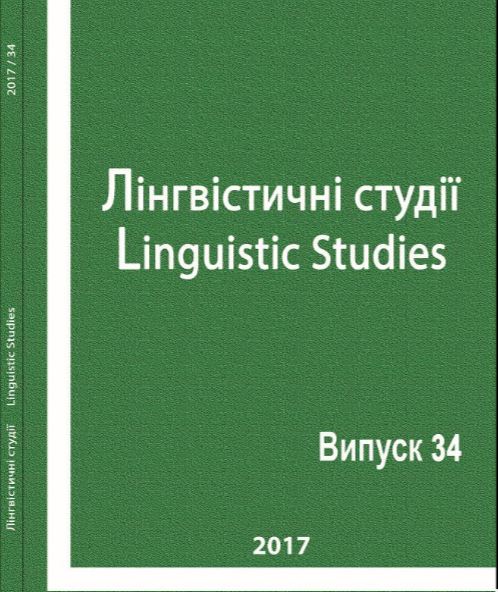Key Sign as an Influential Basis in the Structure of the Linguistic-Semiotic Code of Advertising Communication: Problems of Identification.
Keywords:
advertising communication, linguistic-semiotic code, key sign, addressee, suggestion, manipulationAbstract
Key sign is a core of the structure of the linguistic-semiotic code of advertising communication, its maximally informative and pragmatically significant element.
We conducted the identification of key signs in two stages. At the first stage, we identified the key signs on the verbal level with the help of the methods of observation and Milton-model identification. On the example of communicative codes, which represent the addressee of advertising, we have installed that their verbal key signs are pragmonyms, verbs, nouns, which denote the denominations, pronouns I / me / us / ours. At the second stage, we determined the key signs on the nonverbal (visual) level with the help of the method of observation. Non-verbal key signs of communicative codes are homogeneous (logos, figures, graphic slogans) and heterogeneous (visually-shaped, visually-kinesthetic and visually-auditory).
References
Andreychuk, Nadiya. ―Potentsial linhvosemiotychnoyi interpretatsiyi dlya rozvytku perekladoznavchykh studiy (The Potential of Linguistic-Semiotic Interpretation for the Development of Translation Studies Studies)‖. Zapysky z romano-hermansʹkoyi filolohiyi (Notes from the Romance-Germanic Philology) 1 (34) (2015): 8–14. Print.
Biletska, Olena. ―Hrafosemiotychne koduvannya naratyvnoyi polifoniyi v anhlomovnomu postmodernistskomu khudozhnomu teksti (Graphic Coding of Narrative Polyphony in English Postmodern Fiction Text)‖. Diss. Odessa I. I. Mechnikov National U., 2016. Print.
Brazgovskaya, Yelena. Yazyki i kody. Vvedeniye v semiotiku kultury (Languages and Codes. Introduction to the Semiotics of Culture). Perm, 2008. Print.
Chernyavskaya, Valeriya. Lingvistika teksta. Polikodovost, intertekstualnost, interdiskursivnost (Linguistics of the Text. Polikidovost, Intertextuality, Interdiscursivity). Moscow: LIBROKOM, 2009. Print.
Dronseika, Regina. ―K voprosu ob egotsentrizme lichnogo mestoimeniya «ya» i altruizme lichnogo mestoimeniya «my» (na primere prozy B. Akunina) (On the question of egocentrism of the personal pronoun ―I‖ and the altruism of the personal pronoun ―we‖ in Boris Akunun's prose)‖. Yazyk i kultura (Language and Culture) 1 (2012): 8–32. Print.
Formanova, Svitlana. ―Klyuchovi slova u movniy kartyni Mykhayla Kotsyubynskoho (The Key-words in the World Language‘s System in the Texts of Mikhailo Kotsubinsky)‖. Diss. Institute of Language by O. O. Potebnya National Academy of Science of Ukraine, 1999. Abstract. Print.
Ivanchenko, Viktoriya. ―Linhvoprahmatychni aspekty reklamy vynnykh vyrobiv (na materiali frantsuzkoyi movy) (Linguopragmatic Aspects of the Advertisement of Wine Products (on the Material of the French Language))‖. Problemy semantyky, prahmatyky ta kohnityvnoyi linhvistyky (Problems of Semantics, Pragmatics and Cognitive Linguistics) 21 (2012): 169–175. Print.
Karpenko, Olena. ―Problematyka kohnityvnoyi onomastyky (The issue of cognitive onomastics). Odessa: Astroprynt, 2006.Print.
Kovalevska, Anastasiya. ―Metamodel linhvistychnoyi suhestyvnosti politychnykh reklamnykh slohaniv (Metamodel of political advertising slogans‘ linguistic suggestion)‖. Odeskyy linhvistychnyy visnyk (Odessa linguistic bulletin) 3 (2014): 99–109. Print.
Kovalevska, Tetiana. ―Aktualni napryamy doslidzhennya verbalnoyi suhestiyi (Essential Trends of Verbal Suggestion Researching)‖. Odeska linhvistychna shkola: koordynaty suchasnykh poshukiv (Odessa Linguistic School: Coordinates of Modern Searches). Odessa: Publisher Bukayev Vadim Victorovich, 2014: 323–331. Print.
Kovalevska, Tetiana. Komunikatyvni aspekty neyrolinhvistychnoho prohramuvannya (Communicative Aspects of Neurolinguistic Programming). Odessa: Astroprint, 2008. Print.
Kulikova, Anastasiya. ―Features, Advantages and Disadvantages of Subtitling as One of the Main Types of Audiovisual Translation‖. Language and Culture 14 (2011): 352–357. Web. 8 Oct. 2017.
Kutuza, Natalya. ―Suhestyvnist reklamnoyi mimikriyi (The Suggestiveness of Advertisement Mimicry)‖. Odeska linhvistychna shkola: koordynaty suchasnykh poshukiv (Odessa Linguistic School: Coordinates of Modern Searches). Odessa: Publisher Bukayev Vadim Victorovich, 2014: 484–492. Print.
Lysa, Nataliya. ―Strukturni ta linhvoprahmatychni osoblyvosti reklamnoho znaka (na materiali anhlomovnoyi reklamy) (Structural and Linguo-Pragmatic Peculiarities of the Advertising Mark (based on English Advertising Materials))‖. Diss. Lviv Ivan Franko National U., 2003. Print.
Murashko, Marianna. ―Proektno-khudozhniy instrumentariy moushn-dyzaynu (na prykladi reklamnoho rolyka) (Design and Artistic Tools of Fashion Design (based on an Advertising Video))‖. Diss. Kharkiv State acad. of design and arts, 2016. Print.
Myasninkina, Liubov. ―Cubstantynivnist yak osnovna oznaka reklamnoho tekstu (Substintivity as Basic Sign of Publicity Text)‖. Visnyk Lvivskoho universytetu. Seriya Zhurnalistyka (Visnyk of Lviv University. Series Journalism) 37 (2013): 425–432. Print.
Olenyuk, Olena. ―Kohnityvno-dyskursyvni kharakterystyky vplyvu na adresata (na materiali anhlomovnoyi zhurnalnoyi reklamy)) (Cognitive-discursive Characteristics of Influence on the Addressee (on the Material of the English Magazine Advertisement))‖. Diss. Lviv Ivan Franko National U., 2016. Print.
Petrushova, Nataliya. ―Kod u strukturi komunikatyvnoho aktu (Code in the Structure of the Communicative Act)‖. Filolohichni nauky (Philological Sciences) 9 (2015): 78–84. Print.
Porshnev, Boris. O nachale chelovecheskoy istorii (problemy paleopsikhologii) (On the beginning of human history (the problem of paleopsychology)). Moscow: Mysl, 1974. Web. 14 Oct. 2017.
Prosalova, Vira, and Nikonenko, Uliya. ―Formy vyrazhennya avtorskoyi svidomosti v lirytsi Liny Kostenko (Forms of the expression of author‘s consciousness in lyrics by Lina Kostenko)‖. Zbirnyk naukovykh prats profesorskovykladatskoho skladu DonNU imeni Vasylya Stusa (Collection of scientific works of the professorial teaching staff of Vasyl Stus DonNU) 1 (2017): 36–38. Print.
Romanuyk, Andriy, and Romanyshin, Mykola. ―Model semantyky v linhvistychniy teoriyi Functional Discourse Grammar (Model of Semantics in the Linguistic Theory Functional Discourse Grammar)‖. Visnyk Natsionalnoho universytetu ―Lvivska politekhnika‖ (Bulletin of the National University ―Lviv Polytechnic‖) 685 (2010): 20–29. Print.
Shcherbak, Olena. ―Produktyvni typy semiotychnykh kodiv v ukrayinskiy komertsiyniy telereklami (Productive Types of Semiotic Codes in Ukrainian Commercial TV Advertising)‖. Zapysky z ukrayinskoho movoznavstva (Notes on Ukrainian Linguistics) 23 (2016): 261–270. Print.
Stankevych, Uliya. ―Movni suhestoheny v tekstakh politychnoyi reklamy (Lingual Suggestion Categories in the Political Advertising Texts)‖. Diss. Odessa I. I. Mechnikov National U., 2011. Abstract. Print.
Stepanov, Victor. ―Semioticheskiye kody v reklamnom tekste (Semiotic Codes in the Advertising Text)‖. Analitika kulturologii (Analytics of Culturology) 3 (2012): 92–100. Web. 6 Oct. 2017.
Zubkova, Margarita. ―Sposoby kreolizatsii teksta v angloyazychnoy sotsialnoy reklame (Methods of Creolizing the Text in English Social Advertising)‖ Vestnik VGU. Seriya : Filologiya. Zhurnalistika (Bulletin of the VSU. Series: Philology. Journalism) 4 (2015): 121–123. Print.
Zymovets, Halyna. ―Erhonimy ta prahmonimy v strukturno-semantychnomu ta linhvoprahmatychnomu aspektakh (Ergonyms and Pragmonyms in Structural-Semantic and L


